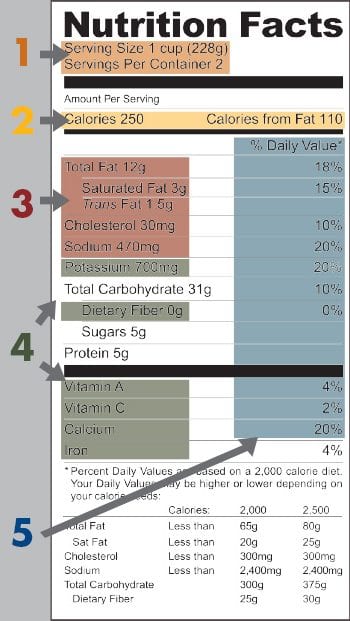

Nutrition Facts labels are required by the Food and Drug Administration on most packaged foods and beverages. Understanding them is especially important if you have health conditions, such as high blood pressure or high cholesterol, or are trying to lose or maintain weight. They are a helpful tool in planning a healthy diet.
1. Serving Size
A serving size of this food is one cup. So all the nutrition information on the label is based upon one cup. There are two servings per container. If you eat two servings the nutrients are doubled.
2. Amount of Calories
The 250 calories listed are for one serving, and 110 — or 44 percent — of the calories are from fat.
3. Limit These Nutrients
Don’t eat too much of these nutrients. Fat — especially saturated fat and trans fat — cholesterol and sodium may increase your risk of heart disease, stroke, high blood pressure and some cancers.
The American Heart Association recommends the following daily limits.
- Total fat — 25 to 35 percent of total calories
- Saturated fat — less than 7 percent of total calories
- Trans fat — less than 1 percent of total calories
- Cholesterol — less than 200 milligrams
- Sodium — less than 2,400 milligrams a day for most healthy people; less than 1,500 milligrams for those with high blood pressure and African American adults
4. Get Enough of These Nutrients
Eat foods with fiber, vitamin A, vitamin C, calcium and iron to improve overall health and reduce the risk of certain diseases and conditions, such as osteoporosis and anemia.
5. Percent Daily Value
This section indicates how the nutrients contribute to your total daily diet based on a 2,000 calorie a day diet.
• Low level of nutrients — 5 percent or less of the daily value. Low levels are good for sodium but bad for fiber.
• High level of nutrients — 20 percent or more. High values are good for vitamins but bad for cholesterol.
Snapshot of this serving
What’s good?
- High in calcium
- High in potassium
- Moderate in number of calories
What’s bad?
- Low in dietary fiber, vitamin A, vitamin C and iron
- High in sodium and calories from fat
- Contains saturated and trans fats







